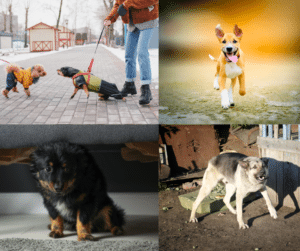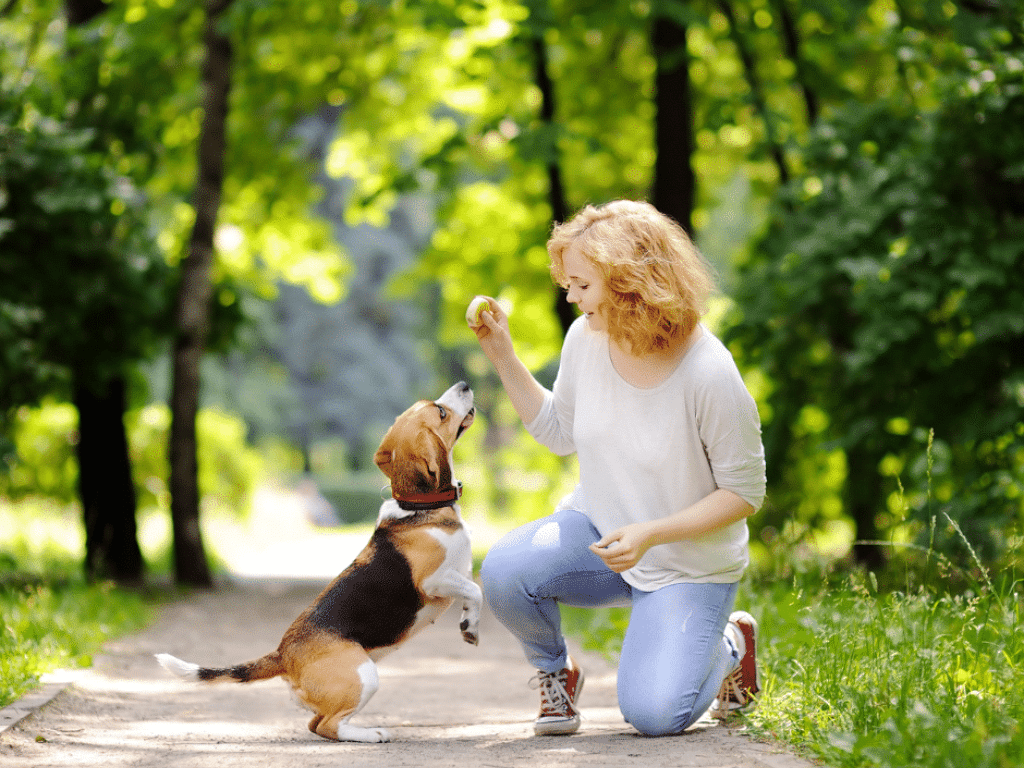Introduction
Dogs are more than just pets; they’re family. But just like family, communication can sometimes be a challenge. Ever wished you could understand what your dog was saying? You’re not alone. Many dog owners find it tough to decipher their canine companions’ language. This guide, crafted by leading experts in dog training in Hamilton, will walk you through the ins and outs of dog communication, helping you build a stronger bond with your furry friend.
The Importance of Speaking Dog Language
Understanding dog language is not just a cool trick; it’s a fundamental part of responsible pet ownership. When you can read your dog’s cues, you can respond appropriately to their needs, avoiding misunderstandings that could lead to behavioural issues or stress. It’s not just about commands like “sit” or “stay”; it’s about recognising when your dog feels anxious, excited, or even unwell. This knowledge helps build a bond based on trust and respect, leading to a happier and healthier relationship.
The Basics of Dog Communication
Dog communication involves a blend of body language, vocalisations, and behaviours. It’s like learning a new language—you need to understand the grammar (body language), the vocabulary (vocalisations), and the context (environment). Dogs use these elements to express their emotions and intentions, and once you understand them, you can “speak” dog fluently.
Tail Wagging: What Does It Mean?
Tail wagging is often seen as a sign of a happy dog, but there’s more to it than just a wag. A high tail wag might indicate excitement or alertness, while a low wag could suggest fear or submission. A fast, frantic wag could mean the dog is excited or anxious, whereas a slow, measured wag might indicate curiosity or uncertainty. It’s not just the wag; it’s also about the height, speed, and direction of the tail. Observing these nuances can give you valuable insights into your dog’s mood.
Ears: A Key Indicator of Mood
Ears are one of the most expressive parts of a dog’s body. When a dog has its ears perked up, it usually means they’re alert and interested. If the ears are laid back against the head, it could indicate fear, submission, or even aggression. Floppy ears can be harder to read, but you can often gauge a dog’s mood by other factors like tail position and body language. Learning to read ear positions can help you understand your dog’s emotional state at a glance.
Understanding Dog Vocalisations
 Dogs have a wide range of vocalisations, from barks to growls to whines. Barking is the most common, but it’s important to understand the context. A high-pitched bark might indicate excitement or playfulness, while a deep, guttural bark could signal aggression or alertness. Growling can mean many things—it could be playful during a game of tug-of-war or a warning if a dog feels threatened. Whining often indicates discomfort or a desire for attention, while howling might suggest loneliness or an attempt to communicate with other dogs. Listening carefully to these vocal cues can give you a better understanding of your dog’s emotions.
Dogs have a wide range of vocalisations, from barks to growls to whines. Barking is the most common, but it’s important to understand the context. A high-pitched bark might indicate excitement or playfulness, while a deep, guttural bark could signal aggression or alertness. Growling can mean many things—it could be playful during a game of tug-of-war or a warning if a dog feels threatened. Whining often indicates discomfort or a desire for attention, while howling might suggest loneliness or an attempt to communicate with other dogs. Listening carefully to these vocal cues can give you a better understanding of your dog’s emotions.
Facial Expressions and Eye Contact
A dog’s face can tell you a lot about how they’re feeling. A relaxed dog might have a slightly open mouth, perhaps even with a hint of a smile. Bared teeth, on the other hand, are a clear sign of aggression or fear. Eye contact is another critical indicator. Dogs that maintain intense, direct eye contact could be feeling threatened or assertive, while those with soft, gentle gazes are more likely to be relaxed and comfortable. Understanding these facial cues can help you respond appropriately to your dog’s needs.
Body Posture and Movements
The way a dog holds its body is a major clue to its emotional state. A dog with a relaxed posture, a wagging tail, and a slightly open mouth is usually content. In contrast, a dog with a stiff body, raised hackles, and a tense tail might be feeling aggressive or defensive. The movements dogs make can also be telling. A dog that moves in slow, deliberate steps might be cautious or hesitant, while one that bounces around with excitement is likely feeling playful. By paying attention to these movements, you can better understand your dog’s behaviour.
Calming Signals
Calming signals are subtle behaviours dogs use to reduce stress and avoid conflict. These signals include yawning, licking lips, turning the head away, or even scratching. If you notice these behaviours, your dog might be feeling anxious or overwhelmed. The key is to respond in a way that helps calm your dog, such as by speaking softly or giving them some space. Recognising these signals can help you prevent stressful situations from escalating.
Common Misunderstandings in Dog Communication
One common misunderstanding is thinking that all tail wags are the same. As mentioned earlier, different tail wags can indicate different emotions. Similarly, growling isn’t always a sign of aggression—it can also occur during play or if a dog feels threatened. Another misconception is that a dog rolling onto its back is always inviting belly rubs. Sometimes, this posture is a sign of submission or fear. By dispelling these myths, you can better understand your dog’s communication style and avoid misinterpretations.
How to Approach a Dog for Better Communication
Approaching a dog the right way can make a significant difference in how they respond to you. It’s best to avoid approaching head-on, as this can be intimidating. Instead, approach from the side and let the dog come to you. Keep your movements slow and calm, and use a gentle voice. If the dog seems nervous, give them space and time to adjust. Approaching in this way creates a more comfortable environment for your dog, leading to better communication.For hands-on guidance, consider enrolling in our private training sessions in Hamilton, where you can practice these approaches with professional support.
Training Tips to Improve Dog Communication
Training, especially with professionals skilled in dog training in Hamilton, is key to improving communication with your dog. Start with basic commands like “sit,” “stay,” and “come.” Use positive reinforcement—treats, praise, or play—to encourage good behaviour. Consistency is crucial; the more consistent you are with your commands and rewards, the easier it will be for your dog to understand what you expect. Training also helps establish boundaries and builds trust between you and your dog.
Recognising Aggressive Signals
Recognising aggressive signals is essential for safety. Aggression can manifest in various ways, such as bared teeth, raised hackles, a stiff tail, or a low growl. If you see these signs, it’s best to back off and give the dog space. Never punish a dog for showing aggressive signals; this can escalate the situation. Instead, focus on calming your dog and addressing the underlying cause of the aggression. If you’re struggling to manage your dog’s aggressive signals, our private trainingsessions in Hamilton can offer personalised support and strategies tailored to your dog’s needs.
The Role of Breed in Dog Communication
Different dog breeds might have unique communication traits. For example, herding breeds like Border Collies are known for their high energy and vocalisations, while toy breeds like Chihuahuas might rely more on body language due to their smaller size. Understanding your dog’s breed characteristics can provide insights into their communication style and behaviour. However, remember that each dog is unique, so it’s essential to consider their individual personality and experiences.
The Benefits of Understanding Dog Language
Understanding dog language offers numerous benefits. It can improve your relationship with your dog, making them more likely to respond to your cues and commands. It also reduces stress for both you and your dog, as you can better anticipate and address their needs. Additionally, understanding dog language can help prevent behavioural issues and create a safer environment. When you can communicate effectively with your dog, you’re better equipped to provide the care and guidance they need.
In Conclusion
 Speaking dog language is a journey, not a destination. Due to the busy environment, dog training in Hamilton requires time, patience, and practice. With the help ofdog training professionals such as K9 Principles, we can guide you through the ongoing process of learning to speak dog language and the rewards are worth it. By understanding your dog’s communication, you can build a stronger bond and create a happier, healthier environment for your canine companion. Remember, it’s not just about learning the signs; it’s about connecting on a deeper level.
Speaking dog language is a journey, not a destination. Due to the busy environment, dog training in Hamilton requires time, patience, and practice. With the help ofdog training professionals such as K9 Principles, we can guide you through the ongoing process of learning to speak dog language and the rewards are worth it. By understanding your dog’s communication, you can build a stronger bond and create a happier, healthier environment for your canine companion. Remember, it’s not just about learning the signs; it’s about connecting on a deeper level.
- Name: K9 Principles
- Address: Haldimand County, Greater Hamilton Area, Burlington and Most of Norfolk County
- Phone: 289 880-3382
- Email: k9principlesinc@gmail.com
- Website: www.k9principles.ca
FAQs
-
Your dog might be barking at night for several reasons, including boredom, anxiety, or sensing something unusual. Try to identify the cause and address it appropriately.



